Bodyweight:
- Glute bridges (variations: single-leg, elevated, banded)
- Single-leg hip thrusts
- Step-ups
- Fire hydrants
- Clamshells
Free Weights:
- Dumbbell Romanian Deadlifts
- Barbell Hip Thrusts
- Bulgarian Split Squats
- Barbell Glute Bridges
- Dumbbell Lunges
Resistance Bands:
- Resistance Band Kickbacks
- Resistance Band Side Squats
- Monster Walks
- Banded Clamshells
- Banded Glute Bridges
Other:
- Jump Squats (with proper form)
- Walking Lunges
- Donkey Kicks
- Cable Pull-Throughs
- Hip Abduction Machine (gym setting)
Remember: The best alternative depends on your fitness level, goals, and equipment availability. Experiment and find what works best for you! After this article, you need to read another article I wrote about >>>> Breathe New Life into Your Storage: Alternatives to Cabinet Doors. to learn about different alternatives.
Ditch the Machine: Exploring Effective Alternatives to Cable Kickbacks for Sculpted Glutes.
Cable kickbacks have long been a gym staple for targeting and strengthening the glutes. But what if you lack access to a cable machine, or crave some exercise variety? Fear not, glute warrior! In my 25 years of experience reviewing, testing, and recommending fitness equipment and exercises, I’ve discovered a treasure trove of alternatives that pack an equally potent punch. Let’s delve into the world beyond cable machines and explore options that fit your fitness level, goals, and preferences.

Bodyweight Bonanza: Unleash Your Inner Powerhouse.
Who needs fancy equipment when your own bodyweight acts as your gym? These bodyweight exercises are perfect for beginners and seasoned exercisers alike:
- Glute Bridges: A classic for a reason. Lie on your back with your knees bent and feet flat on the floor. Lift your hips off the ground, squeezing your glutes at the top, and then lower back down with control. Keep your core engaged throughout. This move is simple yet highly effective, and you can progress by holding the bridge at the top for longer or adding single-leg variations.
- Single-Leg Hip Thrusts: Elevate your glute game with this unilateral challenge. Start lying on your back with one knee bent and your foot flat on the floor. Extend the other leg straight and thrust your hips up, squeezing the glute of the working leg. Lower back down with control and repeat on the other side. This exercise demands balance and coordination, making it a fantastic core and glute strengthener.
- Step-Ups: Mimic everyday movements while sculpting your glutes with step-ups. Find a sturdy step or platform and step up with one leg, bringing your other knee towards your chest at the top. Step back down and repeat on the other leg. This exercise works for multiple muscle groups and gets your heart rate up for a calorie-burning bonus.
- Fire Hydrants: Don’t let the name fool you – this exercise is pure glute magic. Start on all fours with hands shoulder-width apart and knees hip-width apart. Keeping your core engaged, lift one leg out to the side, maintaining a 90-degree bend at the knee and hip. Squeeze your glute at the top, then lower back down with control. Repeat on the other side. This move targets the gluteus medius, improving hip stability and preventing injuries.
Free Weight Fiesta: Sculpt and Strengthen with Iron.
Ready to up the ante? Grab some dumbbells or barbells and explore these free-weight alternatives:
- Dumbbell Romanian Deadlifts: This compound exercise hits your glutes, hamstrings, and lower back. Stand with feet hip-width apart, holding dumbbells in front of your thighs. Hinge at the hips, pushing your hips back and keeping your back straight. Lower the weights towards the ground until you feel a stretch in your hamstrings, then return to standing by squeezing your glutes. This exercise requires proper form to avoid injury, so start light and focus on technique.
- Barbell Hip Thrusts: The undisputed glute-building champion. Lie on your back with a barbell across your hips. Push your heels into the ground and thrust your hips up, squeezing your glutes at the top. Lower back down with control. This exercise allows for heavy weights and is ideal for advanced exercisers. However, ensure you have access to a squat rack and proper guidance for safe execution, especially if you have back problems.
- Bulgarian Split Squats: Build unilateral strength and stability with this challenging exercise. Stand with one leg behind you on a bench or platform. Keeping your torso upright, lunge forward with the front leg, lowering your hips until both knees are bent at 90 degrees. Push through your front heel to return to standing and repeat on the other side. This exercise requires balance and coordination, making it a great tool for improving overall athleticism.

Resistance Band Revolution: Portable Powerhouse for Glute Gains.
Resistance bands offer a convenient and versatile way to target your glutes at home or on the go:
- Resistance Band Kickbacks: Similar to cable kickbacks, but with a band! Secure the band around a sturdy anchor point and attach it to one ankle. Keeping your core engaged and back straight, kick your leg back, squeezing your glute at the top. Return to the starting position with control and repeat on the other side. This exercise offers variable resistance throughout the movement, making it adaptable for different fitness levels.
- Resistance Band Side Squats: Step up your hip stability and inner/outer thigh engagement with this exercise. Loop a resistance band around your thighs just above your knees. Stand with feet hip-width apart and walk sideways, taking small steps and keeping your knees slightly bent. This exercise is fun, and engaging, and works wonders for preventing injuries.
Pros and Cons of Cable Kickbacks: Weighing the Options.
Cable kickbacks have their own set of advantages and disadvantages to consider:
Pros:
- Isolation: They effectively isolate the gluteus maximus, allowing for targeted strengthening.
- Controlled Movement: The cable machine provides a smooth and controlled range of motion, ideal for beginners or those recovering from injuries.
- Adjustable Resistance: Easily adjust the weight to match your fitness level and goals.
Cons:
- Machine Dependence: Requires access to a cable machine, limiting accessibility.
- Awkwardness: Some people find the machine setup and exercise execution awkward compared to free-weight movements.
- Limited Range of Motion: Cable machines often restrict the natural range of motion compared to some body weight or free weight exercises.
Remember, the “best” alternative depends on your individual needs and preferences. Consider these factors when choosing your glute-sculpting routine:
- Fitness Level: Beginners might start with bodyweight exercises, while advanced exercisers can explore free weights or resistance bands.
- Goals: Do you prioritize isolation, strength building, or functional movement? Choose exercises that align with your goals.
- Equipment Availability: If you lack access to a gym, bodyweight or resistance band options offer convenient solutions.
- Personal Preference: Experiment and find exercises you enjoy and find effective.
With this diverse arsenal of alternatives, you can sculpt strong, sculpted glutes without ever setting foot near a cable machine. So, ditch the limitations and embrace the freedom to build your dream glutes wherever you are!
1. What are the best exercises for building strong glutes without a cable machine?
While the above list provides a solid foundation, here are some additional options based on your specific needs:
- For beginners: Glute bridges with variations like single-leg bridges, elevated bridges with a step, or banded bridges. Walking lunges, bodyweight squats, and clam shells are also excellent choices.
- For advanced exercisers: Bulgarian split squats with weights, barbell glute bridges with elevated hips, deficit Romanian deadlifts, and jump squats with proper form can provide an intense challenge.
- For targeting specific glute areas: Side-lying hip abductions with weights or bands target the gluteus medius, while donkey kicks or cable pull-throughs focus on the hamstrings and glutes.

2. How can I modify cable kickbacks to make them easier or harder?
- Easier: Reduce the weight, use lighter ankle cuffs, or shorten the range of motion by keeping your knee slightly bent throughout the movement.
- Harder: Increase the weight, use heavier ankle cuffs, perform the exercise on one leg at a time, or add a pause at the top of the contraction.
3. Are there any risks associated with cable kickbacks?
Using an improper form or exceeding your weight capacity can lead to lower back pain or knee injuries. Ensure you maintain a neutral spine throughout the movement, keep your core engaged, and don’t round your shoulders. Listen to your body and stop if you experience any pain.
4. What are some common mistakes people make when doing cable kickbacks?
- Rounding the back: This puts excessive stress on your spine. Maintain a straight back and engage your core to protect your lower back.
- Swinging the weights: Use your glutes to power the movement, not momentum. Avoid swinging the weights to compensate for lack of strength.
- Not focusing on the mind-muscle connection: Squeeze your glutes at the top of each contraction to maximize muscle activation.
5. How often should I train my glutes to see results?
Aim for 2-3 glute-focused workouts per week, allowing at least one day of rest in between sessions for muscle recovery. Consistency and proper form are key to seeing results.
Remember, consulting a certified personal trainer can provide personalized guidance and exercise recommendations based on your individual needs and fitness level. Happy glute sculpting!
Conclusion: Embrace the Versatility of Glute Training.
Cable kickbacks offer a valuable tool for glute sculpting, but they’re just one piece of the puzzle. This exploration has revealed a treasure trove of alternative exercises, each with its own unique benefits and challenges. Whether you’re a gym enthusiast, a homebody, or a beginner yearning for glute gains, there’s an option waiting to ignite your workout routine.
Remember, the most effective approach is the one you enjoy and can stick with consistently. So, experiment, discover what resonates with your body and preferences, and embrace the freedom to build those sculpted glutes beyond the limitations of any single machine. With dedication and the right tools, you’ll be well on your way to achieving your glute goals!
I am commitment to crafting compelling narratives and delivering insightful content continues to inspire and inform readers across various platforms. Explore her articles on AlternativesZone.com and FactAfterFact.com to experience a rich tapestry of knowledge and discovery. Here I Analyze and Test the products and services together with my team before we recommend them to our users. Nice Reading Here!








No responses yet